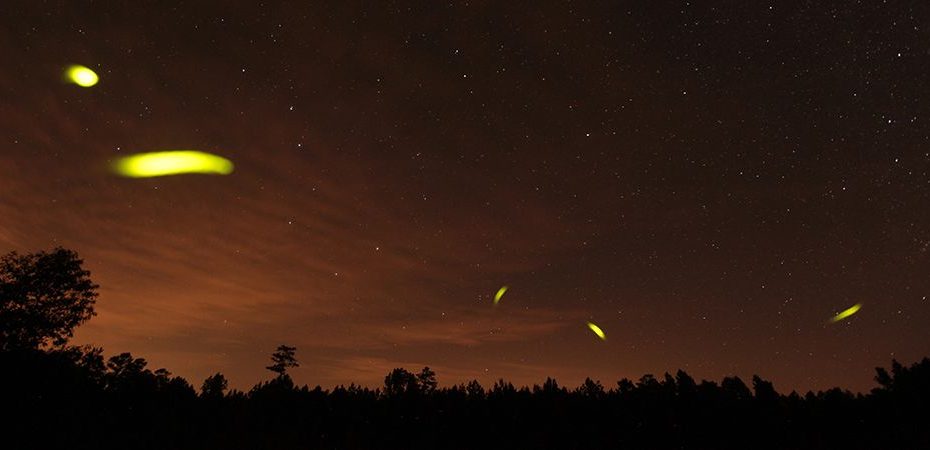I remember the first time I saw a firefly, on a lonely Ohio road one summer night. I was about eight years old, and I’d read about them, but I never saw any where I grew up in suburban Ontario until about five years ago when I stumbled upon a cluster of them near my home. There was maybe a dozen of them flickering deep in the forest. Since then, I’ve seen fireflies in seemingly increasing numbers each year. Over the last few summers, some have even found their way into my yard.
These sights left me wondering – What is going on? Are firefly populations increasing or decreasing?
Fireflies above a forest © John Flannery CC BY-SA 2.0
A recent study of North American fireflies presents an ambiguous picture: of the 132 species of fireflies from Canada and the United States that were studied, 14% (18 species) were threatened with extinction. The number that stood out was that no determination could be made for 53% of species studied due to insufficient data.
So why is it that fireflies have received such little attention?
Though beautiful to watch, the role fireflies play in the ecosystem is still something of a mystery. Dr. Hume Douglas, a research scientist with the government of Canada, says fireflies are beneficial for managed ecosystems, like farms, because they consume slugs and snails in the larval stage before they can feast upon the crops.
“Slugs and snails eat a lot of biomass, which has an impact on vegetation. [Fireflies] could be slowing the breakdown of organic matter,” Dr. Douglas says. “By consuming the animals that would be consuming that organic matter, it keeps carbon sequestered as well.” Still, Hume says more research is needed.
Firefly, Kitchener © Ryan Hodnett CC BY-SA 2.0
Candace Fallon, Senior Conservation Biologist with the Xerces Society for Invertebrate Conservation, says that firefly research has tended to focus on things like their bioluminescence, evolution and courtship, which, though important, does not directly address population change. There’s simply insufficient monitoring.
Fallon says monitoring efforts in Canada and the United States have been scarce for several reasons:
Many fireflies are difficult to identify by morphology alone
The taxonomy of fireflies’ species is in flux
Standardized monitoring protocols for the various types of fireflies (flashing, glow-worm and diurnal) have yet to be developed
Funding is limited
Nevertheless, Fallon says things are changing. “Now that we are gaining a better sense of how fireflies are doing – especially in light of recent studies on insect declines more broadly – that message is getting louder and being shared more broadly,” she says.
Fireflies above a rural field © joronjubilee CC BY-NC-ND 2.0
One monitoring program to emerge in recent years is Firefly Watch, a collaborative effort in community science between the Massachusetts Audubon Society and Tufts University in the United States.
Open to anyone in Canada and the United States, participants are asked to spend 10 minutes once a week observing fireflies.
Dr. Christopher Cratsley, Firefly Watch’s chief scientist and professor at Fitchburg State University, says he and his colleagues were often approached by members of the public who used to see fireflies as children but no longer do.
Concerning anecdotes like these and abiding commitment to biodiversity conservation led Firefly Watch to investigate firefly population numbers.
After a few years of collecting data, Cratsley says there was no evidence that fireflies were on the decline. However, Cratsley and others feared this question lacked precision because it failed to distinguish one firefly species from another.
Fireflies, Frontenac Provincial Park © Ted Goldring CC BY 2.0
They decided to launch Firefly Watch Pro for more experienced volunteers. Instead of just counting flashes, these volunteers are asked to determine what species of firefly they are looking at. Once enough data is collected, Firefly Watch hopes to have a better idea of the state of each species.
Beyond those participating in Firefly Watch, there are no organized or systematic studies of fireflies in Ontario or anywhere else in Canada at the time of writing. However, in this vacuum there is opportunity. “The positive side of ignorance is that there is stuff to explore and learn,” says Dr. Douglas. “Students, amateurs or anyone who gets into it could make great discoveries about fireflies.”
Community science projects, like Firefly Watch, are as essential for monitoring firefly populations as the Ontario Breeding Bird Atlas is for birds. If you see fireflies in your area, consider taking part in Firefly Watch or ask your local conservation group what they are doing to protect fireflies. With so many unknowns, it is essential we study them before it is too late.
The post Fireflies of Ontario – What We Know and What is Yet to be Discovered appeared first on Ontario Nature.
